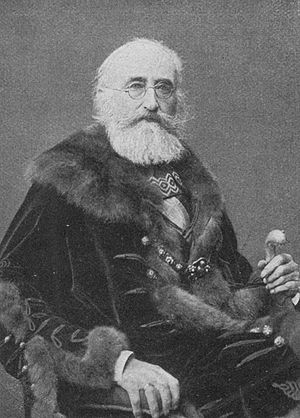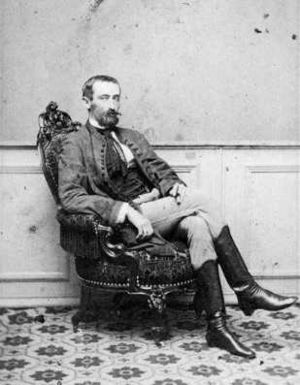Kálmán Tisza facts for kids
Quick facts for kids
Noble
Kálmán Tisza
de Borosjenő
|
|
|---|---|
 |
|
| 9th Prime Minister of the Kingdom of Hungary | |
| In office 20 October 1875 – 13 March 1890 |
|
| Monarch | Francis Joseph I |
| Preceded by | Béla Wenckheim |
| Succeeded by | Gyula Szapáry |
| Personal details | |
| Born | 16 December 1830 Nagyvárad, Kingdom of Hungary |
| Died | 23 March 1902 (aged 71) Budapest, Hungary |
| Political party | Resolution Party (1861) Left Centre (1865–1875) Liberal Party (1875–1902) |
| Spouse | Ilona Degenfeld-Schonburg |
| Children | István Paulina Kálmán Lajos |
| Parents | Lajos Tisza de Borosjenő Juliánna Teleki de Szék |
Kálmán Tisza de Borosjenő (born December 16, 1830 – died March 23, 1902) was a Hungarian prime minister. He led Hungary from 1875 to 1890. He is known for creating a strong, unified Hungarian government. He also founded the new Liberal Party in 1875. His major economic changes helped save the country. These changes also led to a government that people supported. He was the second longest-serving head of government in Hungarian history.
Contents
Kálmán Tisza's Political Journey
When Kálmán Tisza was 18, Hungary's political system changed a lot. It went from an old-fashioned feudal state to a new constitutional monarchy. This new system was much like modern governments. New laws ended old councils and created a two-part parliament. This parliament had a House of Lords and a House of Representatives.
Democratic ideas also grew. A law allowed 6.5% of the people to vote. Other laws united traditional Hungarian lands. These big changes led to a nationalist uprising. This uprising ended with the Habsburg family being removed from power during the Hungarian Revolution of 1848-49.
The Hungarian revolution was defeated. Many of the new reforms were taken back. Hungary was then ruled by Austrian general Julius Haynau. Even though the revolution ended, its ideas for a parliamentary government remained. In 1859 and 1860, Austria saw that Hungarians supported the Italians in the Austro-Italian wars. Because of this, Austria started trying new ways of governing Hungary.
During this time, Kálmán Tisza was first elected to the new government. Then, in 1867, Tisza helped negotiate with Emperor Franz Joseph I. This led to the Compromise of 1867 (called Ausgleich in German and Kiegyezés in Hungarian). This important agreement gave Hungary back its constitutional powers. Only defense and foreign affairs remained under the Emperor's control.
These changes helped Tisza become Prime Minister. In 1875, he started the Liberal Party. He was then elected Prime Minister of Hungary. The government was not very efficient at first. So, Tisza spent his 15 years in office reforming the government and the economy.
Making Government Stronger
Hungary's new government system was not working well. It lacked a central way of doing things. One of Kálmán Tisza's first actions as Prime Minister was to make the government stronger. He turned it into a single, effective system. This meant that the government officials were in charge of elections. They also made sure the Liberal Party stayed in power. The parliament and the party then made these actions seem official.
Tisza made the government more powerful. The parliament's main job became to approve what the government did. He also reformed the parliament itself. Some members had held their seats for a very long time without being challenged.
Changes to the House of Magnates
Tisza removed 469 members from the House of Magnates. The number of members was set to 369. This included 205 members who inherited their seats. There were also 83 church leaders and 81 new life members. The Emperor still gave noble titles. But the Prime Minister could suggest who should get these titles. In emergencies, the Prime Minister could even ask for new members to be appointed. This helped pass important laws.
These changes made the Prime Minister the most important person in Hungarian politics. Tisza's reforms helped him gain more power within the Hungarian government. They also reduced the influence of the Austrians. He helped Hungary become more politically independent from Austria.
Improving the Economy
Between 1869 and 1875, Hungary tried to run its economy like France. But their political system was more modern than their old economic system. For example, collecting taxes was like a military campaign. It only raised taxes by 11%. This made people in the countryside very unhappy. These six years were a time of poor economic management.
When Tisza became Prime Minister in 1875, he improved the economy. He did this in ways similar to how he strengthened the government. He started tax reforms that saved the country from going bankrupt. In 1889, Sándor Wekerle became Minister of Finance. He worked with Tisza to create a new tax system. This system focused on taxing land.
These reforms were very successful. Even though the land tax went up by 30%, government income increased by 330%. Between 1880 and 1895, public money doubled because of these successful tax changes. The Tisza-Wekerle system saved the government from bankruptcy. However, the tax system was very strict. It eventually made it hard for a local market to grow for Hungarian products.
Kálmán Tisza's Legacy
Kálmán Tisza made huge contributions during his 15 years as Prime Minister. He was born when the Austrian Imperial government in Hungary was struggling. He also took over a Hungarian government that was not working well. But he managed to turn Hungary into a modern state.
He saved his country from going completely bankrupt. He also created a strong and efficient central government. His reforms and successes gave confidence to the Hungarian people. They had been controlled by the Austrians and were learning how to govern themselves.
However, he is also linked to a policy of promoting Hungarian culture and language. This policy aimed to unify the country under Hungarian influence. His son, István Tisza, also became a well-known Hungarian politician.
Awards and Honors

 Austria-Hungary: Grand Cross of the Royal Hungarian Order of Saint Stephen, 1880
Austria-Hungary: Grand Cross of the Royal Hungarian Order of Saint Stephen, 1880
See also
 In Spanish: Colomán Tisza para niños
In Spanish: Colomán Tisza para niños


